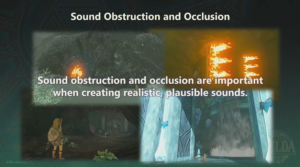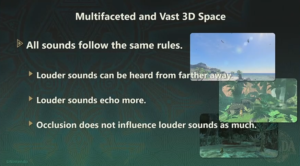Tears of the Kingdom Had a “Physics Engine for Sound,” Developers Share
Posted on April 14 2024 by Nicole Scott
Tears of the Kingdom’s Lead Sound Engineer, Junya Osada, Physics Programming Lead, Takahiro Takayama, and the Technical Director, Takuhiro Dohta, revealed fascinating insights about the game at the 2024 Game Developers Conference. The three gave a presentation called “Tunes of the Kingdom: Evolving Physics and Sounds for The Legend of Zelda: Tears of the Kingdom,” which gave fans an exciting behind-the-scenes look into an underrated aspect of the game.
Tears of the Kingdom’s technical achievements are arguably the reasons behind the game’s success, as recent interviews unveil the complexity behind the systems. However, background music and sound effects may get overlooked in the face of the game’s robust gameplay and programming physics.
Osada discussed just how much the sound team challenged the industry’s perception of technical audio engineering. Director Hidemaro Fujibayashi coined their achievement as a “physics system for sound.”
Osada begins his explanation with how traditional sound engineering works in older titles, including Skyward Sword and Twilight Princess. Many players know interacting with certain objects or events causes specific sounds or songs to appear. The sound library is reactive, such as signaling when there is an opening to attack during a boss fight or in Skyloft’s Bazaar when the songs change time signatures between the different vendors.
Tears of the Kingdom was different, and sound needed more rules. The game’s sandbox nature — or what Dohta described more specifically as multiplicative gameplay — required something more intricate. Players would assemble creations with Ultrahand and Fuse, playing with the world in ways a conventional sound system would not complement. Additionally, the types of environments, like the Sky and cave systems, required each sound to echo and bloom in realistic ways.
“We thought that perhaps real-world acoustic characteristics could be those rules. And so we decided to go back to the basics of what it means to make sound in a 3D space.”
So, they developed a tool to handle their sound demands.
The sound effects and music knew when there were stronger enemies nearby. They even programmed the Shrines of Light to reduce volume after being there for awhile — perhaps the reduced noise will help you think through the puzzle more clearly.
But there’s more: Osada explained how they designed automated parameters to tell when Link was in certain places, whether behind a wall or transitioning from sky to ground. It wasn’t enough to program a sound effect on a flying arrow, making the impact volume less as it was further away. It also had to consider if Link was in the Colosseum or a forest; the acoustics and ambient sounds are specific to these locations. Complex physics would determine Link’s space and adjust acoustics, reverb, and other object metrics for a seamless experience.

“In this game, the sound system performs calculations for the audio listener based on the camera’s position, but searches for sound pass between the sound’s force and Link’s position… Each and every sound now plays naturally in the game’s space. But now that I mention it, there is an incredible amount of freedom in this world that it would not be possible to prepare dedicated audio files for all of the many different things that can be created with Ultrahand.”
What does this look like in the game? The sound team combined abstract noises instead of sounds with dedicated implementation. They provided the example of an Ultrahand-assembled wagon, which does not play a stock wagon-riding noise. Instead, it is a combination of the rolling wheels, jangling chains, and creaking joints culminating in the wagon sound.
Each object has physics-informed, programmed characters, and the team undertook the challenge of designing algorithms and systems that considered every item’s qualities against this spacious, diverse environment. Sound designers even stated they were surprised by some of the sounds they heard in the game, claiming they didn’t make them — the dynamism of the game did. What a magical feat!
Does this make you appreciate the sounds of Hyrule even more? Let us know your thoughts on the GDC panel in the comments!
Source: Game Developer
Editor’s Note: This article has been edited to include the full Tears of the Kingdom GDC 2024 presentation.

Nicole Scott is writer for Zelda Dungeon from suburban Appalachia. She loves drinking espresso, seeing live music, building LEGO sets, being a completionist, and snuggling her two probably-alien cats, Tizo and Alarielle.






